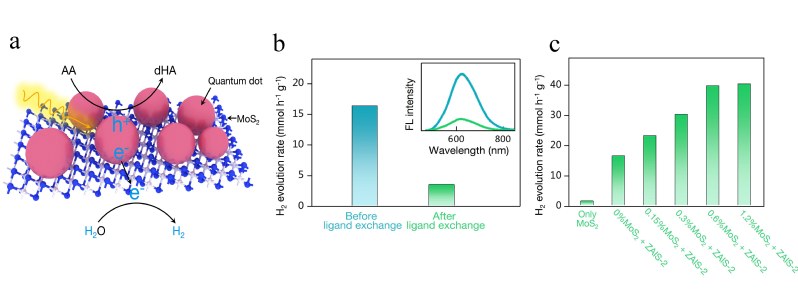School of Physical Science and Technology Professor Ning Zhijun’s team recently made progress on photocatalytic hydrogen generation. They developed a high efficiency, low toxicity photocatalytic system based on colloidal quantum dots with broad absorbance in visible region.Their paper, “0D–2D Quantum Dot (QD): Metal Dichalcogenide Nanocomposite Photocatalyst Achieves Efficient Hydrogen Generation,” was recently published in Advanced Materials.
Photocatalytic hydrogen generation provides an effective strategy to solve energy and environmental issues. The development of photocatalytic system with strong light harvesting capability in visible region and high catalytic efficiency is a prerequisite for its large-scale application. However, generally there is a trade-off between high efficiency and a broad absorbance in visible region. The problems undermined are the reduction of driving force for catalysis and serious carriers recombination associated with relatively small bandgap light harvesting materials. In recent years, 0D quantum dot has been receiving wide attention for its excellent light absorption capability in visible region and high hydrogen generation efficiency. The Ning lab synthesized 0D Zn-Ag-In-S quantum dots capped with Glutathione as ligands. In combination with cations composition engineering, the defect concentration was effectively reduced, as evidenced by the control experiment via ligand exchange. In contrast with the traditional view that “defects are helpful to improve the photocatalytic efficiency,” this work indicates that for a photocatalytic light harvesting materials with small bandgap, reducing defects is the key to improve photocatalytic efficiency. This finding provides a clue to improve the efficiency of photocatalytic system of small bandgap.
To further enhance carriers’ separation and catalysis efficiency, colloidal QDs were anchored on a two-dimensional MoS2 nano sheet acting as hydrogen generation catalyst. This design enables better carrier separation by effective electron injection from QDs to MoS2. Together with excellent catalytic performance of MoS2, the hydrogen generation rate is significantly improved to 40.1mmol·h-1·g-1 under the simulated sunlight conditions. This performance is ranked among the top values reported for cadmium free low-toxic photocatalytic hydrogen generation system. The work also indicates that the integration of nanomaterials of different dimensions can combine the advantages of each component, providing an avenue to build high performance photocatalytic system.
Professor Long Yitao’s teams from East China University of Science and Technology, researchers from Low Carbon Center of Shanghai Advanced Research Institute belonging to Chinese Academy of Science, Shanghai Applied Physical Institute at Chinese Academy of Science, China University of Science and Technology, and University of Toronto joined together on this research. This work was supported by start-up funding from ShanghaiTech University, National Science Fund of China and National Basic Research Program, the Science division of Shanghai government, and Chinese Academy of Science.
 a. Scheme of 0D-2D nanocomposite for hydrogen generation under illumination; b. Hydrogen generation performance of nanocomoposite with QDs before and after ligand exchange; c. Hydrogen generation performance of nanocomposites with different concentration of MoS2.
a. Scheme of 0D-2D nanocomposite for hydrogen generation under illumination; b. Hydrogen generation performance of nanocomoposite with QDs before and after ligand exchange; c. Hydrogen generation performance of nanocomposites with different concentration of MoS2.
- About
- News
- Faculty
- Research
-
Academics
- School of Physical Science and Technology (SPST)
- School of Life Science and Technology (SLST)
- School of Information Science and Technology (SIST)
- School of Entrepreneurship and Management (SEM)
- School of Creativity and Art (SCA)
- Institute of Humanities (IH)
- School of Biomedical Engineering (BME)
- Shanghai Institute for Advanced Immunochemical Studies (SIAIS)
- iHuman Institute
- Institute of Mathematical Sciences (IMS)
- Center for Transformative Science (CTS)
- Institute of Carbon Neutrality (ICN)
- Shanghai Clinical Research and Trial Center
- Tech Transfer
- Global
- Campus Life

